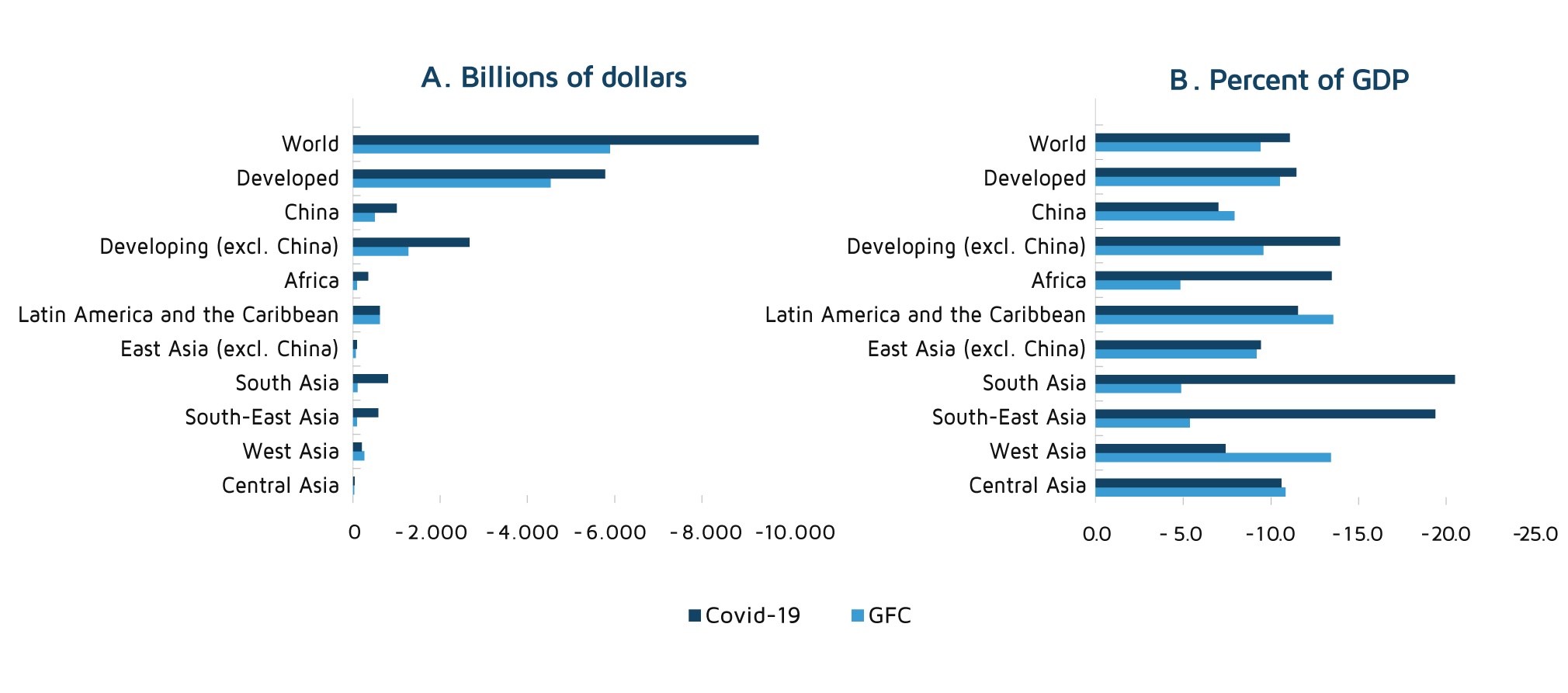Following a year of sharp economic decline triggered by the coronavirus pandemic, many countries worldwide are expected to see their growth rates bounce back in 2021. Global growth is forecast to reach 5.3%, the highest rate in almost five decades, according to a report released by the UN Conference on Trade and Development. This U-turn is largely due to staunch policy interventions that kicked off in 2020.
However, despite the positive forecast, the recovery is uneven across regions, let alone the prospect that the growth rate might decelerate in 2022, particularly if austerity policies are disregarded.
Moreover, the gap between advanced and emerging economies is expected to widen, deteriorating development trends, partly because of the lack of monetary autonomy in developing countries and also because of uneven vaccine availability.
Commenting on this state of affairs, Rebeca Grynspan, UNCTAD Secretary-General, said, “These widening gaps, both domestic and international, are a reminder that underlying conditions if left in place, will make resilience and growth luxuries enjoyed by fewer and fewer privileged people. Without bolder policies that reflect reinvigorated multilateralism, the post-pandemic recovery will lack equity, and fail to meet the challenges of our time.”
Regional dynamic
The coronavirus pandemic has damaged many economies across the world more so than during the global financial crisis (GFC). Developing countries, particularly in Africa and South Asia, have suffered the most, according to the report.
Fig.1. The economic impact of GFC, 2009–2010, vs. Covid-19, 2020–2021

North America and Europe
In 2020, the United States and Canada experienced a GDP contraction of 3.5% and 5.4% respectively despite massive state support programs. According to the report, the total growth rates in 2021 and 2022 are expected to reach 5.7 % and 3% respectively in the United States, and 5.1% and 2.9% respectively in Canada.
In Europe, the largest economies, France, Germany, Italy, and the UK, saw their growth rates contracting by 8%, 4.9%, 8.9%, and 10% respectively. In 2021, France and Italy are expected to record 5.2% and 5.5% real growth rates while Germany is projected to reach only a 2.2% real growth rate as it had the lowest contraction in 2020. According to UNCTAD’s expectations, Italy will not return to its 2019 GDP level next year, unlike France and Germany whose growth rates are forecast to stand at 3.4% and 3.2% respectively in 2022. As for the UK, its growth is estimated to reach 6.7% and 2.1% in 2021 and 2022, respectively.
Latin America and the Caribbean
Being badly impacted by the coronavirus pandemic, this region recorded a sharp decline with the GDP rate contracting by 7.1% in 2020. In 2021, GDP is expected to grow by only 5.5%. However, the report anticipates that the region will return to its pre-pandemic 3.0% level of growth in 2022.
Russia, Asia and Oceania
Despite gloomy forecasts, Russia’s GDP contracted by 3% in 2020, avoiding the expected 3.9% decline. As most of its economic sectors have reported an upward dynamic, UNCTAD expects Russia to record a GDP growth of 3.8% in 2021 and 2.3% in 2022.
In the meantime, Asia saw growth rates zigzagging strongly across its regions in 2020. The Central Asian region experienced only a slight GDP reduction of 0.3% in 2020 while South Asia reported a 5.6% fall in GDP. South-East Asia witnessed a contraction of GDP by 3.9% and Western Asia by 2.9%. East Asia demonstrated resilience in 2020 with a GDP growth rate equal to 0.3%.
UNCTAD expects East Asia to experience a dynamic recovery with a growth rate equal to 6.7% and 4.7% in 2021 and 2022, respectively. In contrast, UNCTAD foresees a comparatively moderate growth of 4.3% and 3.1% in Central Asia, 5.8% and 5.7% in South Asia, 3.5% and 4.7% in South-East Asia, and 3.5% and 3.2% in Western Asia, for 2021 and 2022, respectively.
For its part, Oceania, with a 2.4% growth contraction, registered its first negative result for the last three decades. However, UNCTAD expects the region will recover in 2021with growth rates of 3.1% and 2.8% in 2021 and 2021, respectively.
Africa
This region, strongly damaged by the pandemic, entered recession in 2020 with a GDP contraction of 3.4% which wiped out years of development achievements. UNCTAD expects the entire continent to grow by 3.2% in 2021 before decelerating to 2.9% in 2022.

